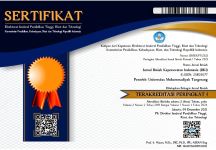Nursing Student Perceptions About The Role Of The Tutor And Implementation Of The Tutorial Process Using The Seven Jumps Technique
Abstract
Seven jumps is an approach used in the problem solving learning method or Problem Based Learning (PBL). The seven jumps technique implemented using the tutorial method directed by a tutor. The tutor's role is one of the critical factors for the success of the tutorial process. Students' perceptions of the tutor's role will affect the pros and cons of implementing tutorials. Therefore, it is necessary to test the role of the tutor and implementation of the tutorial process. The purpose of this study was to find the perceptions of nursing students about the role of the tutor and implementation of the tutorial process using the seven jumps technique. This study used a descriptive design. The population in this study was students of the regular program of the Faculty of Nursing, University of Riau. The sample in this study amounted to 222 people who recruited using simple random sampling technique. The measuring instrument used is a questionnaire made by researchers using google from which has been test for validity and reliability. This study shows that for the tutor role there are 114 respondents (51.4%) who have positive perceptions and 108 respondents (48.6%) have negative perceptions. As for implementation of the tutorial process, there were 117 respondents (52.7%) who had positive perceptions and 105 respondents (47.3%) had negative perceptions. This research expected to test the learning process and optimize the tutor's role in implementing tutorials using the seven jumps technique.
Keywords: Student Perceptions; Tutor; Seven Jump Technique
Full Text:
PDFReferences
Agutina. (2009). Pengaruh Konflik Peran, Ketidakjelasan Peran, dan Kelebihan Peran terhadap Kepuasan Kerja dan Kinerja Auditor. Jurnal Akuntansi Vol, 1 No. 1 Mei 2009: 49-69 Universitas Kristen Maranatha Bandung.
Chairudin Samosir. (2006). Buku saku tutor pendidikan keaksaraan. Medan: BP-PLSP
Duch, et.al. (2001). The Power Of Problem-Based Learning: A Practical “How To” for Teaching Undergraduate Courses in Any Discipline. Sterling: Virginia
Erol, G., Yesin, S., & Mahmet. (2008). Evaluation of problem based learning by tutors and student in a Medical Faculty of Turkey. Kuwait Medical Journal, 40(4), 276– 280
Jaafar, R., Rashid, F. A., Rahim, A. F. A., Arzuman, H., & Yusoff, M. S. B. (2012). Training Module Series: Students Centered Learning (SCL) Approaches For Innovative Teaching Module 5: Approaches to Students Centered Learning. University Sains Malaysia. Diperoleh pada tanggal 22 Januari 2020 dari : http://www.ppsk.usm.
Ngalimun. (2017). Strategi pembelajaran. Yogyakarta : Parama Ilmu.
Rahayu, G. R. (2005). Pmbelajaran Berpusat Mahasiswa. Yogyakarta: Pusat pengembangan pendidikan Universitas Gajah Mada.
Utomo, W., Utami, G.T., Hasneli, Y., & Nurchayati, S. (2014). Students Experience Undergoing Competency Based Curriculum in School of Nursing of Riau University. Prooceding. 2014 Riau International Nursing Conference.
DOI: http://dx.doi.org/10.31000/jiki.v4i2.3150
Article Metrics
Abstract - 4603 PDF - 7072DOI (PDF): http://dx.doi.org/10.31000/jiki.v4i2.3150.g2541
Refbacks
- There are currently no refbacks.
Copyright (c) 2021 Jurnal Ilmiah Keperawatan Indonesia [JIKI]
JIKI: Jurnal Ilmiah Keperawatan Indonesia a Creative Commons Attribution-ShareAlike 4.0 International License. © View My Stats







